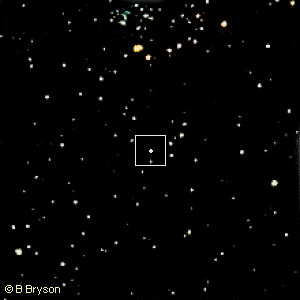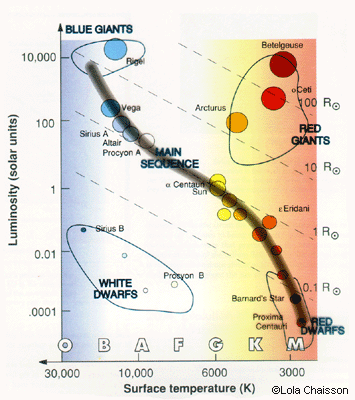More at 10 petametersMy favorite physics class was about stellar evolution. The starting point is the observation that stars are stable for long periods of time. In order that a star maintain that stability, the force from gravity acting to collapse the star must be balanced by the radiation pressure (expressed by the ideal gas law) from inside the star. By equating these two forces, stellar evolution drops out. Well, it's not quite that simple. Careers have been spent on the details. Nobel prizes have been won. Among the many conclusions resulting from this basic relationship between gravity and radiation pressure:
There are several sites that discuss this topic in detail. One of the best that I have found is from an introduction to astronomy course at UC San Diego. The link sends you to the course outline and from there you can jump to the material on the Herzsprung-Russell Diagram. Another good resource, and the source of the HR diagram above, is from Tufts University. The section Stellar Evolution is particularly relevant here, and includes a series of HR diagrams by Lola Chaisson illustrating the evolution of stars of different mass. |

 This
last item is the one I'm interested in here. Elnar Herzsprung and Henry
Norris Russell independently plotted the only properties of stars observable
from Earth -- their color (related to temperature) and their brightness
(luminosity). So that the brightness was not affected by the distance
to a star, they used stars located in clusters located thousands of
light years from the sun. What they discovered was that stars were not
randomly placed on their graph but were grouped in bands and clumps.
Much of what we now understand about the lives of stars can be interpreted
from the H-R diagram and the relationship between gravity and radiation.
This
last item is the one I'm interested in here. Elnar Herzsprung and Henry
Norris Russell independently plotted the only properties of stars observable
from Earth -- their color (related to temperature) and their brightness
(luminosity). So that the brightness was not affected by the distance
to a star, they used stars located in clusters located thousands of
light years from the sun. What they discovered was that stars were not
randomly placed on their graph but were grouped in bands and clumps.
Much of what we now understand about the lives of stars can be interpreted
from the H-R diagram and the relationship between gravity and radiation.